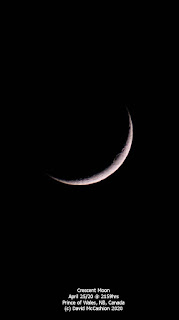Date Time: April 25, 2020 2030-2330hrs
Weather: No wind, mostly clear with some haziness and a few passing clouds. Cool enough to keep the bugs down, except for one moth. Temperature went from 6C down to 3C. Frost on the car windows the next morning.
Equipment: Canadian telescopes 80 ed/apo with Canon rebel t3 attached at prime focus. Images processed with Photoshop.
Attendance: David McCashion
Objective: To observe and image a thin crescent Moon closely approach epsilon Tauri, one of the Taurus the Bulls eyes. Also to observe a Starlink train of satellites passing over at 2135hrs according to Heavens-above.com, and to image three different comets in Camelopardalis.
Report:
- Nice pairing of Venus and a very thin crescent Moon before sky darkened. Sky didn't darken till after 2100hrs.
- While imaging the Moons approach towards Epsilon Tauri, aka "Ain and Oculus Borealis, both of which mean “the eye.”", at 2135hrs, a train of satellites appeared out of the north western sky, to the right of the Moon. Absolutely spectacular! Wasn't prepared for imaging the amazing sight, but after fumbling with the camera to take a long exposure image, I realized that that would only produce a streak in the image. In my opinion, the best way to image this amazing thing is to video it. My cellphone camera couldn't pick up the faint satellites, that were approximately Betelgeuse brightness, and were in close formation, showing differing reddish colors when lower, close to the horizon, then turned white as they passed overhead. Would estimate approx 50 satellites that disappeared long before they got to the south eastern horizon. Another group of about 25 satellites appeared about 15 minutes later. Called my wife and a friend in Saint John to tell them to look for the train and my wife went outside and seen the satellites pass overhead.
- Viewed, with unaided eye, and imaged the Moons approach to Taurus the bulls eye. As it got darker out, it was easier to see the close pairing of the Moon and Epsilon Tauri. The Moon was very close to the star, but I didn't witness it eclipsing the star, which it was supposed to do.
 |
| Earthshine. |
- Orion is sliding in behind the sun for the summer, like it normally does. Just before dark Orion's belt could be seen through the trees on the southwest horizon. Betelgeuse appears to be brightening from its recent dimming phase.
- Located and imaged three comets in Camelopardalis, all between Capella and the western tip of Cassiopeia. First time for me to image three comets so close together in the sky. Beautifully located in the north western sky, this would, no doubt, capture much more attention, if they were brighter. All three images consist of the same settings; 60 second exposures, ISO 6400. Only processing was adding text and reducing image size for sharing purposes. No cropping or other enhancements. Did this to show the brightness and size differences. Obviously, Atlas Y1 is 2nd biggest and the brightest, with Panstarrs T2 being second brightest and the smallest. Comet Atlas Y4, which is falling apart and dimming, is dimmest and seems to be largest, but has a grayish color, where the other comets are showing green in images. Comet Atlas Y1 and Comet Panstarrs T2 also have bright nucleus's, whereas, Comet Atlas Y4 has no bright central region. Another interesting fact, according to heavens-above.com, is that they are all about 1 AU from Earth, with Panstarrs being about 1.7AU from Earth.
 |
| A cropped and collage version of the three comet images below. |
- Many birds were nearby, chirping quacking, and squawking, long after dark. An American Woodcock flew past my setup, just before total dark. Three fast, faint shooting stars were seen with another unconfirmed one out of the corner of my eye. Many dozens of satellites were seen going in either north south direction, or west to east.







No comments:
Post a Comment